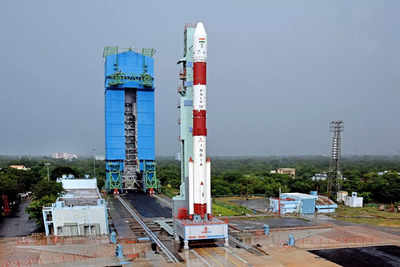- News
- India News
- Isro’s romance with space missions in 2022 to start with 1st launch on V-Day
Trending
This story is from February 9, 2022
Isro’s romance with space missions in 2022 to start with 1st launch on V-Day

NEW DELHI: Isro’s romance with space missions will start this year on Valentine’s Day when the space agency will launch its first satellite Risat-1A. codenamed EOS-4. The earth observation satellite will boost the country’s border security by providing one more ‘eye in the sky’.
The Polar Satellite Launch Vehicle-C52 (PSLV-C52) carrying EOS-04 satellite is scheduled to lift off at 5.59am on February 14. The countdown of 25 hours and 30 minutes leading to the PSLV-C52 launch will commence at 4.29am on February 13 after authorisation by the launch authorisation board.
The countdown of 25 hours and 30 minutes leading to the PSLV-C52 launch will commence at 4.29am on February 13 after authorisation by the launch authorisation board.
The PSLV-C52 rocket is designed to launch EOS-04, weighing 1,710 kg, into a sun-synchronous polar orbit of 529km. EOS-04 is a radar imaging satellite designed to provide high-quality images under all-weather conditions for applications such as agriculture, forestry and plantations, soil moisture and hydrology and flood mapping, an Isro release said.
The rocket will also carry two small satellites — a student satellite (INSPIREsat-1) made by Indian Institute of Space Science & Technology (IIST) in association with the Laboratory of Atmospheric & Space Physics at University of Colorado Boulder, US, and a technology demonstrator satellite (INS-2TD) from Isro, which is a precursor to India-Bhutan Joint Satellite (INS-2B). The INS-2TD was earlier scheduled for launch last year but it faced some technical issues and could not make it to be onboard the previous PSLV-C51 flight.
The 3,025 kg Insat-4B was launched in 2007 by Arianespace’s Ariane 5 rocket. The satellite’s mission life was 12 years. After completing nearly 14 years of on-orbit operations, the C band and Ku band payload services of Insat-4B were seamlessly migrated to other Gsats before commencement of the post-mission disposal, an Isro said.
As per IADC guidelines, a GEO object, at the end-of-life stage, should be raised to a nearly circular orbit well above the GEO belt to prevent its orbit from coming back into the GEO protected region within 100 years of re-orbiting. In this case, the minimum orbit raise required was 273km and this was achieved through 11 re-orbiting manoeuvres executed between January 17 and 23. Insat-4B, which had on July 10, 2010 suffered a disruption in power supply from one of the two solar panels rendering half of its transponder capacity useless, is the 21st Indian GEO satellite to undergo post-mission disposal.
Insat-4B was part of the Indian National Satellite System series of multipurpose geostationary satellites launched by Isro to fulfil India’s telecommunication, broadcasting, meteorology requirements as well as for search & rescue operations. Insat is the largest domestic communication system in the Indo-Pacific Region and is a joint venture of the Department of Space, DoT, IMD, AIR and Doordarshan.
The Polar Satellite Launch Vehicle-C52 (PSLV-C52) carrying EOS-04 satellite is scheduled to lift off at 5.59am on February 14.

The PSLV-C52 rocket is designed to launch EOS-04, weighing 1,710 kg, into a sun-synchronous polar orbit of 529km. EOS-04 is a radar imaging satellite designed to provide high-quality images under all-weather conditions for applications such as agriculture, forestry and plantations, soil moisture and hydrology and flood mapping, an Isro release said.
The rocket will also carry two small satellites — a student satellite (INSPIREsat-1) made by Indian Institute of Space Science & Technology (IIST) in association with the Laboratory of Atmospheric & Space Physics at University of Colorado Boulder, US, and a technology demonstrator satellite (INS-2TD) from Isro, which is a precursor to India-Bhutan Joint Satellite (INS-2B). The INS-2TD was earlier scheduled for launch last year but it faced some technical issues and could not make it to be onboard the previous PSLV-C51 flight.
Isro announced the launch date hours after it revealed that India has successfully decommissioned communication satellite Insat-4B after 14 years of service. It said that as part of India’s continued effort towards preservation of long-term sustainability of outer space, Insat-4B has undergone post-mission disposal (PMD) at the end of its life, followed by decommissioning on January 24 to comply with UN and INTER Agency Space Debris Coordination Committee
(IADC)-recommended space debris mitigation guidelines.
The 3,025 kg Insat-4B was launched in 2007 by Arianespace’s Ariane 5 rocket. The satellite’s mission life was 12 years. After completing nearly 14 years of on-orbit operations, the C band and Ku band payload services of Insat-4B were seamlessly migrated to other Gsats before commencement of the post-mission disposal, an Isro said.
As per IADC guidelines, a GEO object, at the end-of-life stage, should be raised to a nearly circular orbit well above the GEO belt to prevent its orbit from coming back into the GEO protected region within 100 years of re-orbiting. In this case, the minimum orbit raise required was 273km and this was achieved through 11 re-orbiting manoeuvres executed between January 17 and 23. Insat-4B, which had on July 10, 2010 suffered a disruption in power supply from one of the two solar panels rendering half of its transponder capacity useless, is the 21st Indian GEO satellite to undergo post-mission disposal.
Insat-4B was part of the Indian National Satellite System series of multipurpose geostationary satellites launched by Isro to fulfil India’s telecommunication, broadcasting, meteorology requirements as well as for search & rescue operations. Insat is the largest domestic communication system in the Indo-Pacific Region and is a joint venture of the Department of Space, DoT, IMD, AIR and Doordarshan.
End of Article
FOLLOW US ON SOCIAL MEDIA










